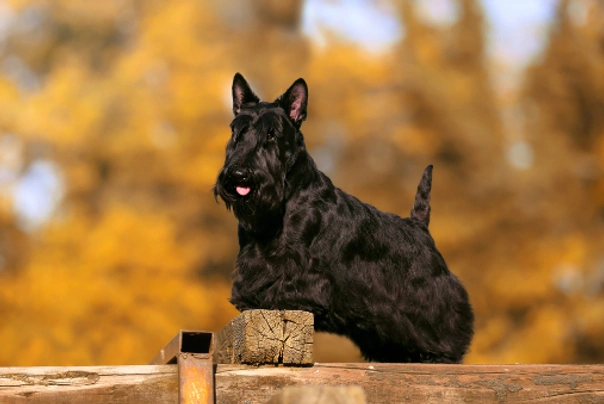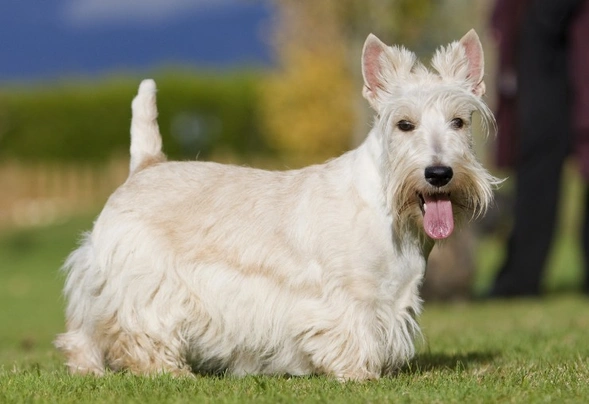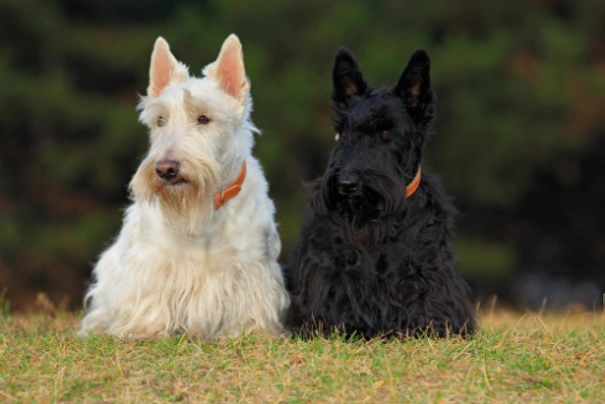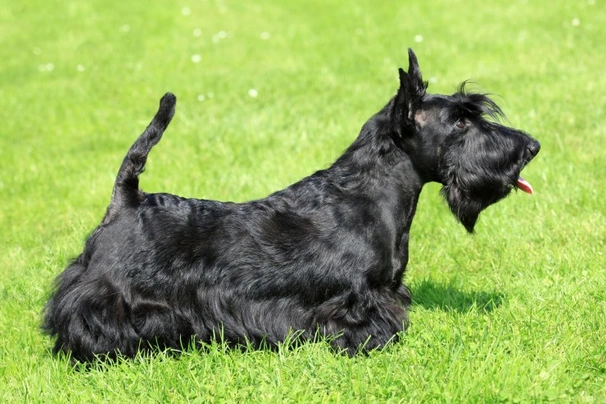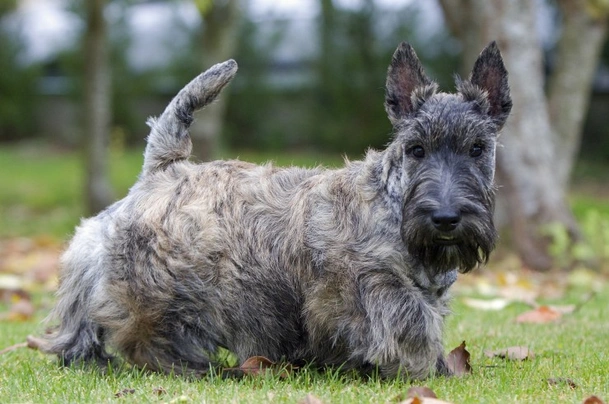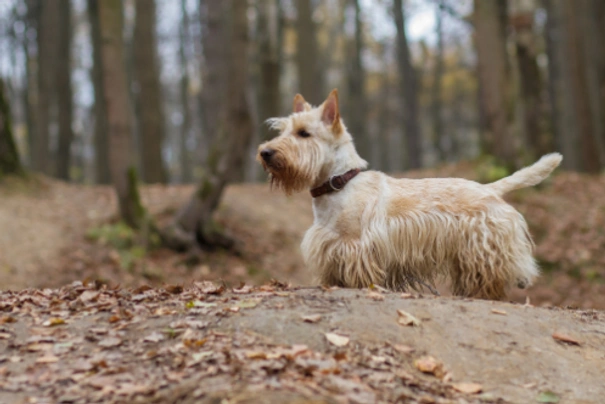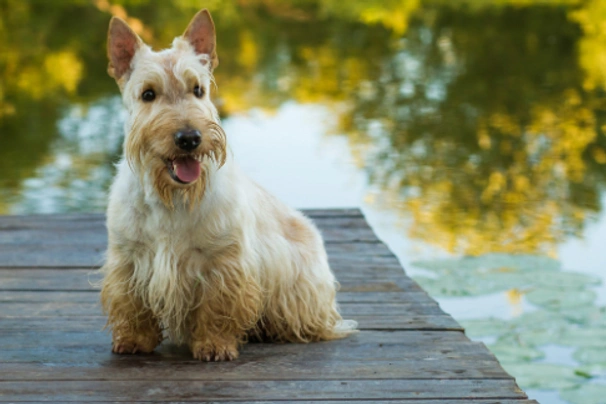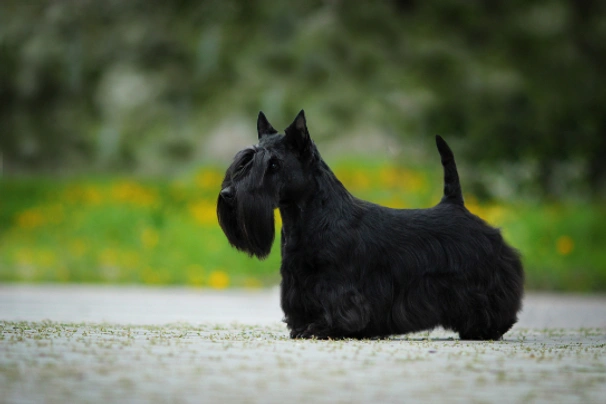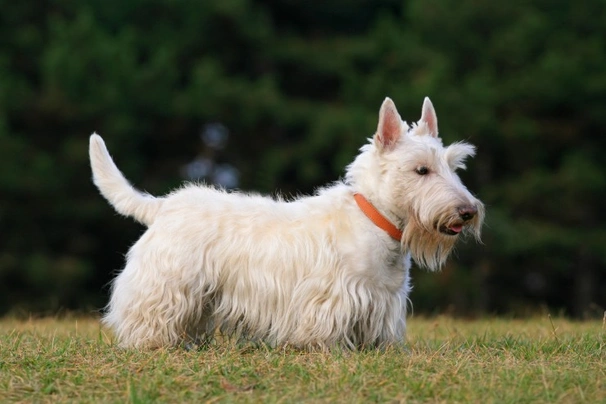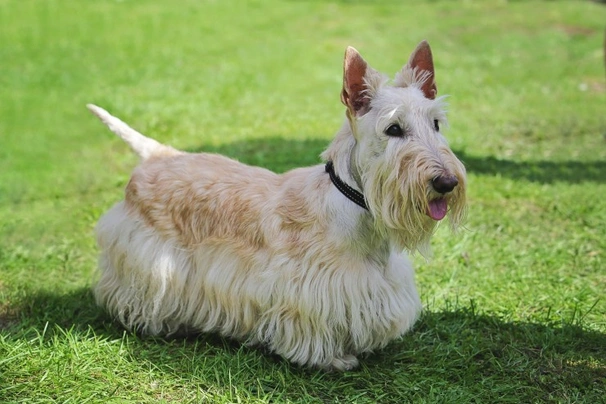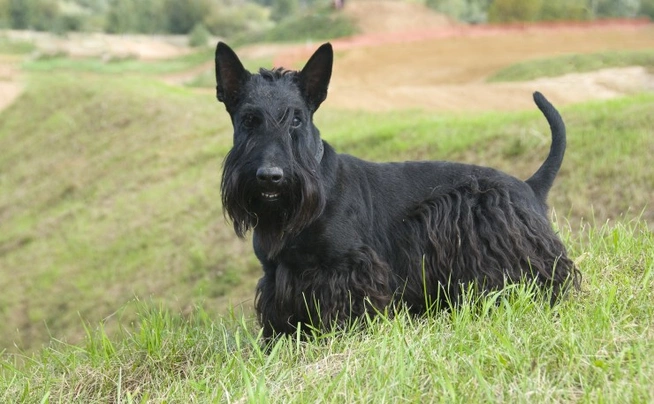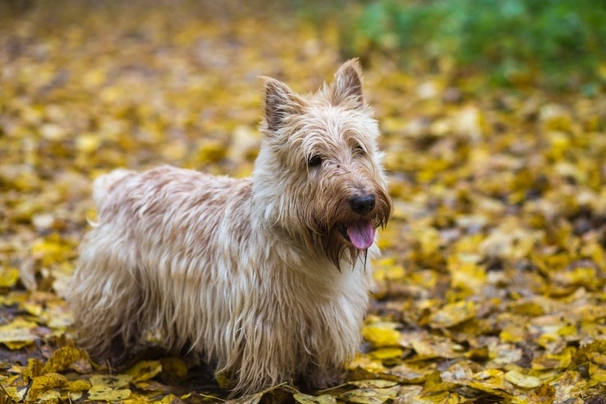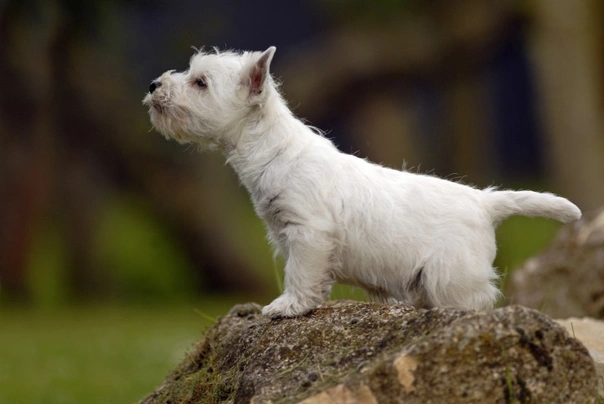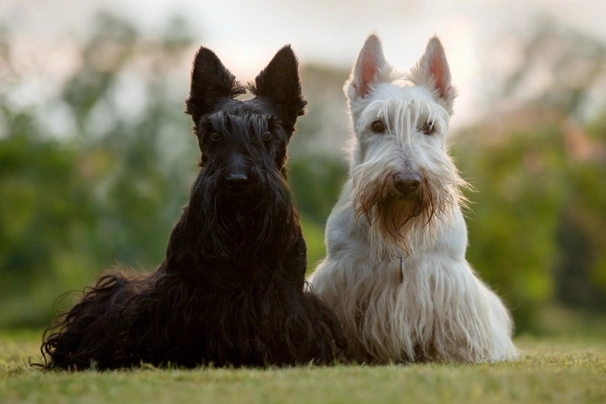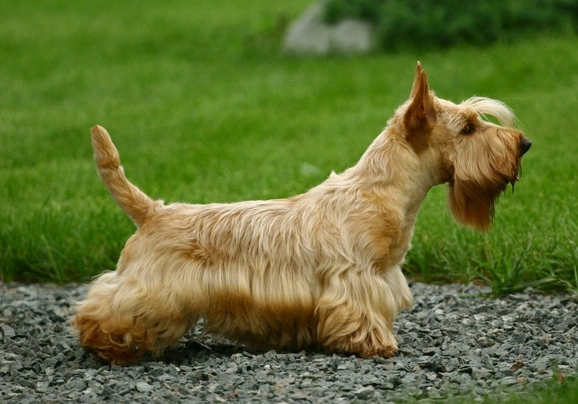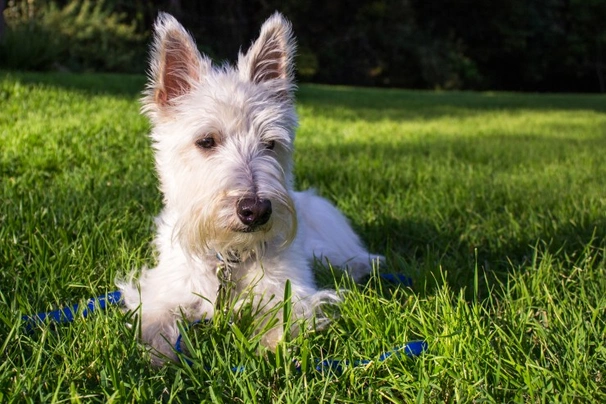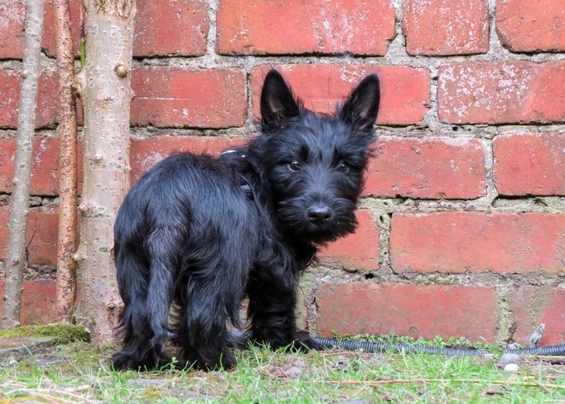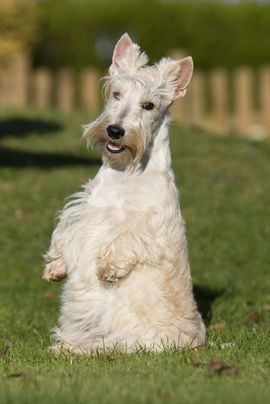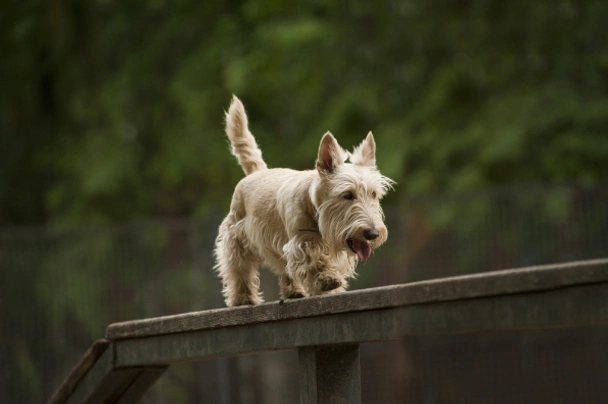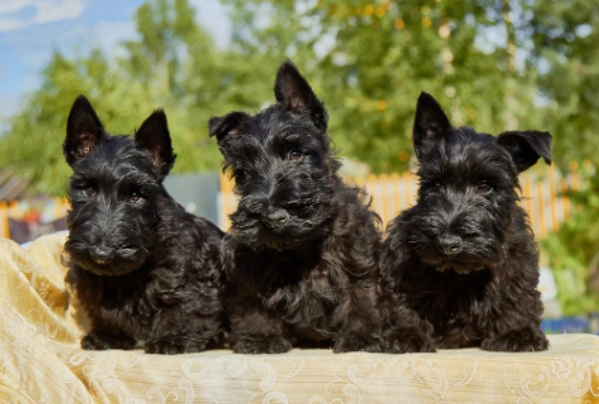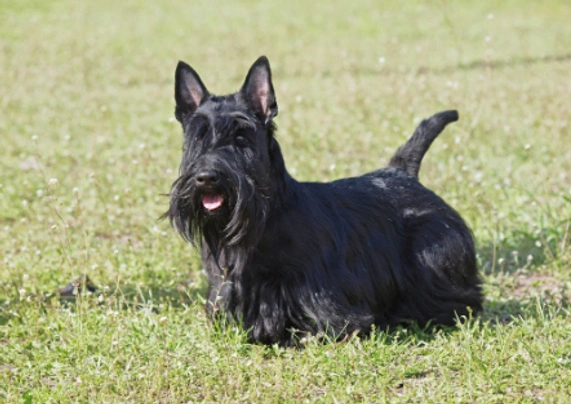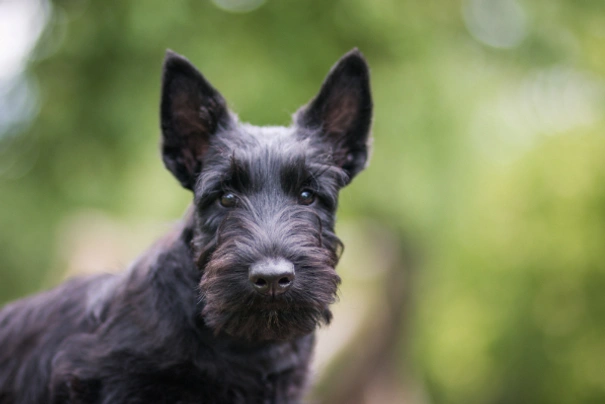Scottish Terrier
Pros
Cons
Introduction of the Scottish Terrier
The Scottish Terrier is a delightful dog and although feisty they make wonderful companions and family pets. Their coats are typically black but brindle and wheaten is also acceptable under the Kennel Club breed standard. Scotties are small dogs with short legs and lots of feathering around their muzzles and on their legs which adds to their charming looks. Often called Aberdeenies they have found their way into the hearts and homes of many people not only in the UK but elsewhere in the world too and for good reason.
Scotties are known to be wonderful companions as well as family pets because they thrive in a home environment and are good around children although they are better suited to families with older children rather than toddlers. The other thing to bear in mind is that a Scottish Terrier’s coat is high maintenance which means they benefit from being professionally groomed several times a year.
History of the Scottish Terrier
The Scottish Terrier is thought to be Scotland's oldest terrier breed but back in the 1800's there was a lack of interest in breeds found north of the border and therefore no written records were kept. It was not until the end of the 18th Century that a Capt. Mackie took an interest in Scottish terriers and spent a few years studying them. He was to become a big enthusiast and kept records of all the terriers he came across with just about every community having packs of terriers which they used to control vermin in highly regions north of the border. These terriers were quite different in size and colour with each community believing their terriers were the truest to type.
At the time Capt. Mackie was studying terriers in Scotland dog enthusiasts south of the border in England were starting to show an interest in breeding and showing dogs. As such the captain took about 60 Scottish Terriers back to England with his and began exhibiting his dog. By the late 1800's he was to become one of the most successful exhibitors of the day. Thanks to these dog shows many breeds that were once just considered to be "working dogs" started to be companions too and the Scottish Terrier began to find a fan base even though these terriers did not boast having the best of temperaments.
It was during the 1930's that Scottish Terriers became some of the more popular breeds not only in the UK but in the United States too. At the outset of the Second World War many English breeders sent their Scottish Terriers over to the States as a way of making sure they survived. President Roosevelt was to become a big fan of the breed which helped promote Scotties throughout the United States. The Scottish Terrier breed standard has been revised several times with it being based on the example set out by the American Kennel Club standard much to the annoyance of the Scottish Terrier Club of England.
There is some belief that Scottish Terriers may be closely related to the West Highland Terrier although as previously mentioned their exact origins are a little unclear since no records of the breed were kept. With this said they are thought to be an ancient breed and one that dates back to 55 BC when similar dogs were described by a Roman philosopher by the name of Pliny the Elder. Roman invaders named these dogs "terrarii" which translated means "workers of the earth".
It is also thought that the Old Scotch Terrier is the foundation breed of all terrier breeds we see today and although these dogs no longer exist they were highly prized for being strong courageous and reliable more especially when they went about the job they were bred to do. Old Scotch Terriers had black or sand coloured coats with short legs and long hair and they boasted having half pricked ears much like Scottish Terriers.
Another similar dog was described in a book called A History of Scotland which was published in 1436. However by the beginning of the 18th century there were many descriptions of two distinct terrier breeds with the rough coated Scottish Terrier being one of them and the smooth coated English Terrier being the other. During the 17th century James I of England offered a few terriers to the King of France and it's thought these dogs would well be the foundation breed for the Scottish Terriers we see today. Thanks to the King's love of the breed their popularity continued to grow.
There were many terrier breeds found in Scotland during the following century but by the end of the 1800's two distinct breeds emerged namely the Dandie Dinmont and the Skye Terrier. These two breeds were classed as Skye Terriers and were exhibited as such right up until the late 1800's. A breed standard was drawn up for the Scottish Terrier around the same time and Skye Terriers were eventually classed as four separate breeds being the Scottish Terrier the Skye Terrier the West Highland White Terrier and lastly the Cairn Terrier. Today the Scottish Terrier remains a popular choice both as a companion and family pet thanks to their charming looks and their kind albeit feisty natures.
Interesting facts about the breed
- Is the Scottish Terrier a vulnerable breed? No Scottish Terriers have consistently remained popular family pets and companions for many years ranking 91 out of 238 breeds on the Pets4homes website
- They have always been highly prized for being excellent “ratters”
- Scottish Terriers are descended from 4 Scotties that were around in the 1870’s named Roger Rough Bon Accord Splinter II and Tartan
- The first records of a Scottie-type dog can be found in the History of Scotland that covers the period from 1436 to 1561
- The first Scottish Terrier Club was founded in England in 1881
- President Roosevelt and George W Bush were big fans of the breed
- Other breed enthusiasts were Queen Victoria and Jacky Kennedy
- Working breeds have traditionally had their tails docked a practice that has been going on throughout time. The reason a working dog’s tail was docked was to prevent them from being damaged when a dog was flushing out and retrieving game in undergrowth. In 1993 that a law was passed preventing anyone other than a vet from carrying out the procedure but this was further changed when The Animal Health and Welfare Act (Scotland) came into effect in 2006 which invoked a total ban on tail docking unless for medical reasons. In other parts of the UK the Animal Welfare Act came into effect in April 2007 which meant that dog's tails could no longer be docked unless they fell into the category of a specific "working" dog or for medical reasons providing the correct paperwork has been submitted by a qualified vet who would undertake to carry out the procedure. There is a heavy fine for anyone who has a dog’s tail docked without submitting the necessary paperwork to the right authorities
Appearance of the Scottish Terrier
Height at the withers: Males 25 - 28 cm Females 25 - 28 cm
Average weight: Males 8.5 - 10 kg Females 8 - 9.5 kg
The Scottish Terrier is a robust muscular little dog and one that boasts a feisty appearance about them. They are well balanced although they boast having extremely large paws which are perfect for digging. They also have a dignified look about them with their long heads and slight stops. They have almond shaped dark brown eyes that are set nicely apart on a dog's face. Their eyes are framed by eyebrows which adds to their endearing appearance. Scotties always have a keen alert and intelligent look about their eyes.
Noses are large and black and their ears are pointed fine to the touch and set nicely on a dog's head which they always carry erect. The Scottish Terrier has a strong jaw with a perfect scissor bite where their upper teeth neatly overlap their lower ones. Their necks are moderately long and well-muscled. Shoulders are sloping with briskets being well let down between a dog's front legs. Their chests are broad and front legs powerful and straight.
Scottish Terriers have well balanced bodies with nicely rounded ribs that carry well back. Their backs are short and extremely muscular with dogs having a straight level topline and muscular deep loins. Their hindquarters are strong with large broad rumps and their back legs boast having well developed thighs. They have large well-padded feet with well arched tight toes with their front feet being a little larger than their back ones. Tails are moderately long and thicker at the base before tapering to the tip which adds to the overall well-balanced look of a dog. Their tails are set quite high which dogs carry erect or with a slight curve in them.
When it comes to their coat the Scottish Terrier boasts having a double close lying coat the consists of a short dense and soft undercoat and a much harsher top coat which is also dense but wiry. The accepted breed colours are as follows:
- Black
- Black Brindle
- Brindle
- Wheaten
Gait/movement
When a Scottish Terrier moves they do so smoothly with a free gait with a good amount of drive both in their front and back quarters always holding a nice level gait.
Faults
The Kennel Club frowns on any exaggerations or departures from the breed standard and would judge the faults on how much they affect a dog's overall health and wellbeing as well as their ability to perform.
Males should have both testicles fully descended into their scrotums and it is worth noting that a dog can be a little lighter or heavier as well as slightly taller or shorter than set out in the Kennel Club breed standard which is given as a guideline only.
Temperament of the Scottish Terrier
Scottish Terriers are renowned for being loyal devoted highly intelligent dogs that form strong bonds with their owners. They thrive in a home environment loving nothing more than to be included in everything that goes on around them. They are dignified sometimes reserved and often quite independent characters but they also boast being quite feisty by nature. Although they are affectionate towards all family members they tend to form a strong tie with one person. This is usually the person who takes the most care of them.
They are known to have a bit of a stubborn streak in them and can be a little aloof around people they don't already know. However rarely would a Scottie show any sort of aggression towards a stranger preferring to keep their distance until they get to know them.
They love digging which can be a problem if a dog starts digging up flower beds or the lawn and which is something that needs to be gently nipped in the bud when dogs are still young before it turns into a real problem. They also boast a high prey drive even in a home environment. They are quite sensitive to their owner's feelings which means that if someone is quiet a Scottie would follow suit but as soon as a person gets up to do something more exciting a Scottish Terrier would be right there with them ready to go.
It's important for these dogs to be well socialised from a young age so they grow up to be confident outgoing mature dogs. Their socialisation must include introducing them to lots of new situations noises people other animals and dogs once they have been fully vaccinated. It's also crucial for their training to start early too and it must be consistent throughout a dog's life. A Scottie is never happier than when they know their place in the pack and who they can look to for direction and guidance. If they don't know who is the alpha dog in a household they may quickly take on the role of a dominant dog which can make them harder to live with and handle.
Are they a good choice for first time owners?
Scottish Terriers are a good choice for first time dog owners because they are so amenable and people-oriented loving nothing more than to please and to entertain their families. They are good around children and older people too which is why they are such lovely companions.
What about prey drive?
Like most terriers Scotties have a high prey drive and will happily chase anything that moves whenever the opportunity arises. As such care should be taken when they are around any pets or animals they don't already know. Care should also be taken as to where and when a Scottie can run free off the lead.
What about playfulness?
Scotties have a very playful and rather mischievous side to their natures and love to entertain and be entertained by their owners. They enjoy playing interactive games which includes things like "fetch" and "find the toy".
What about adaptability?
Scottish Terriers are highly adaptable dogs and providing they are given enough daily physical exercise combined with as much mental stimulation to prevent boredom from setting in they are just as happy living in an apartment in town as they are living in a house in the country. With this said like all dogs they love being able to root around a back garden whenever they can bearing in mind that Scotties can be prolific "diggers" which sees them digging holes in flower beds and lawns for the fun of it.
What about separation anxiety?
Scotties form strong ties with their families and as previously mentioned with the person who takes the most care of them. They are never very happy when they find themselves left on their own for longer periods of time. They are better suited to people who either work from home or in households where one person stays at home when everyone else is out so they are never alone for any length of time which could see a dog suffering from separation anxiety. This can lead to them being destructive around the home which is a dog's way of relieving any stress they are feeling and a way to keep themselves entertained.
What about excessive barking?
Some Scotties like the sound of their own voices a little too much which is something that needs to be gently nipped in the bud when a dog is still young being careful not to frighten them. Others will only bark when there are strangers about or when something they don't like is going on in their surroundings. All dogs may start barking when they are unhappy about something or left to their own devices for too long it's their way of getting attention and relieving any stress they may be feeling.
Do Scottish Terriers like water?
Most Scotties like swimming and will take to the water whenever they can more especially when the weather is hot. However if anyone who owns a dog that does not like water should never force them to go in because it would just end up scaring them. With this said care should always be taken when walking a Scottie off the lead anywhere near more dangerous watercourses just in case a dog decides to leap in and then needs rescuing.
Are Scottish Terriers good watchdogs?
Scottish Terriers are good watchdogs and will quickly let their owners know when strangers are about or when something they don't like is going on in their surroundings. However rarely would a Scottie do so aggressively preferring to keep their distance and bark to alert their owners.
Intelligence / Trainability of the Scottish Terrier
The Scottie is a smart dog and a fast learner. The downside to this is they are just as quick to pick up bad habits as they are the good. As such their training must begin early too. It also must be very consistent and always fair throughout a dog’s life so they understand what their owner expects of them. Scottish Terriers are never happier than when they are given something to do but once they are back home they are just as happy to relax and chill out with their owners.
The key to successfully training a Scottie is to make their training as interesting as possible and to avoid too much repetition. It's also a good idea to keep training sessions short which helps dogs stay more focused on what it’s being asked of them bearing in mind that the more intelligent a dog is the faster they get bored and the Scottish Terrier is a very smart dog.
They do not answer well to harsh correction or any sort of heavy handed training methods but they do respond extremely well to positive reinforcement which always brings the best out of these intelligent and quick-witted dogs especially when there are high value rewards involved. However care should be taken as to how many food rewards are given to a Scottie because they tend to put on too much weight all too easily.
Scottie puppies are incredibly cute and it is all too easy to spoil them when they first arrive in their new homes. However owners should always start out as they mean to go on which means teaching a puppy the limits and boundaries of what is acceptable behaviour and what is not. All dogs are much happier when they know what an owner expects of them and with Scotties it helps reduce the risk of them developing "small dog syndrome" which can make them unruly and harder to live with. The first commands a puppy should be taught are as follows:
- Come
- Sit
- Stay
- Quiet
- Leave it
- Down
- Bed
Children and other
Scottish Terriers are known to be good around children. However they are best suited to households where the children are older and who therefore know how to behave around dogs. They are not the best choice for families with very young children and any interaction between toddlers and a dog should always be well supervised by an adult to make sure things stay nice and calm.
Scotties can be quite territorial which means care should be taken when other dogs come into their environment. They will stand their ground if they feel threatened by another dog but if they are left alone they generally keep to themselves preferring to do their own thing. If they have grown up with a family cat in a household they usually get on well together. However a Scottie would think nothing of chasing off any other cats they encounter because they would see them as fair game. Care should be taken when they are around any smaller animals and pets because of their high prey drive as such any contact is best avoided.
Health of the Scottish Terrier
The average life expectancy of a Scottish Terrier is between 13 and 14 years when properly cared for and fed an appropriate good quality diet to suit their ages.
The Scottie is known to suffer from a few hereditary health issues which are worth knowing about if you are planning share your home with one of these feisty little dogs. The conditions that seem to affect the breed the most include the following:
- Scottie Cramp
- Cushing's Syndrome (Hyperadrenocorticism)
- Hypothyroidism
- Epilepsy
- Craniomandibular Osteopathy
- Liver Shunts
- Juvenile Cataracts
- Cerebellar Abiotrophy
- Congenital deafness - BAER test available through the Animal Health Trust
- Melanomas (cancer) - DNA test available through the Animal Health Trust
- Von Willebrand's Disease - DNA test available
- Patellar luxation
- Transitional cell carcinomas (TCC) - bladder cancer
- Wobbly Dog Syndrome/Ataxia (Cerebellar abiotrophy)
What about vaccinations?
Scottie puppies would have been given their initial vaccinations before being sold but it is up to their new owners to make sure they have their follow-up shots in a timely manner with the vaccination schedule for puppies being as follows:
- 10 -12 weeks old bearing in mind that a puppy would not have full protection straight away but would be fully protected 2 weeks after they have had their second vaccination
There has been a lot of discussion about the need for dogs to have boosters. As such it's best to talk to a vet before making a final decision on whether a dog should continue to have annual vaccinations which are known as boosters.
What about spaying and neutering?
A lot of vets these days recommend waiting until dogs are slightly older before spaying and neutering them which means they are more mature before undergoing the procedures. As such they advise neutering males and spaying females when they are between the ages of 6 to 9 months old and sometimes even when a dog is 12 months old.
Other vets recommend spaying and neutering dogs when they are 6 months old but never any earlier unless for medical reasons. With this said many breeds are different and it is always advisable to discuss things with a vet and then follow their advice on when a dog should be spayed or neutered.
What about obesity problems?
Some Scottish Terriers gain weight after they have been spayed or neutered and it's important to keep an eye on a dog's waistline just in case they do. If a dog starts to put on weight it's important to adjust their daily calorie intake and to up the amount of exercise they are given. Older dogs too are more prone to gaining weight and again it's essential they be fed and exercised accordingly because obesity can shorten a dog's life by several years. The reason being that it puts a lot of extra strain on a dog's internal organs including the heart with disastrous results which is why it's important to keep an eye on a Scottie's weight bearing in mind they do like their food a little too much.
What about allergies?
Some Scotties are prone to suffering from allergies and it's important for a dog to see a vet sooner rather than later if one flares up. Allergies can be notoriously hard to clear up and finding the triggers can be challenging. With this said a vet would be able to make a dog with an allergy more comfortable while they try to find out the triggers which could include the following:
- Certain foods that contain high levels of cereals and other grain fillers
- Airborne pollens
- Dust mites
- Environment
- Flea and tick bites
- Chemicals found in everyday household cleaning products
Participating in health schemes
There are no BVA or KC tests available for Scottish Terriers but all responsible Scottish Terrier breeders would ensure that their stud dogs are tested for known hereditary and congenital health issues known to affect the breed by using the following schemes:
- Congenital deafness - BAER test available through the Animal Health Trust
- Melanomas (cancer) - DNA test available through the Animal Health Trust
- Von Willebrand's Disease - DNA test available
What about breed specific breeding restrictions?
Apart from the standard breeding restrictions for all Kennel Club registered breeds there are no other breed specific breeding restrictions for the Scottish Terrier.
What about Assured Breeder Requirements?
As previously mentioned there are not BVA screening or DNA tests available under the Kennel Club scheme for the Scottish Terrier.
Caring for the Scottish Terrier
As with any other breed Scotties need to be groomed on a regular basis to make sure their coats and skin are kept in top condition. They also need to be given regular daily exercise to ensure they remain fit and healthy. On top of this dogs need to be fed good quality food that meets all their nutritional needs throughout their lives.
Caring for a Scottish Terrier puppy
Scottie puppies are boisterous and full of life which means it's essential for homes and gardens to be puppy-proofed well in advance of their arrival. A responsible breeder would have well socialised their puppies which always leads to more outgoing confident and friendly dogs right from the word go. With this said any puppy is going to feel vulnerable when they leave their mother and littermates which must be taken into account. The longer a puppy can remain with their mother the better although it should never be for too long either.
It's best to pick a puppy up when people are going to be around for the first week or so which is the time needed for a puppy to settle in. Puppy-proofing the home and garden means putting away any tools and other implements that a boisterous puppy might injure themselves on. Electric wires and cables must be put out of their reach because puppies love chewing on things. Toxic plants should be removed from flowerbeds and the home too.
Puppies need to sleep a lot to grow and develop as they should which means setting up a quiet area that's not too out of the way means they can retreat to it when they want to nap and it's important not to disturb them when they are sleeping. It's also a good idea to keep "playtime" nice and calm inside the house and to have a more active "playtime" outside in the garden which means puppies quickly learn to be less boisterous when they are inside.
The documentation a breeder provides for a puppy must have all the details of their worming date and the product used as well as the information relating to their microchip. It is essential for puppies to be wormed again keeping to a schedule which is as follows:
- Puppies should be wormed at 6 months old
- They need to be wormed again when they are 8 months old
- Puppies should be wormed when they are 10 months old
- They need to be wormed when they are 12 months old
Things you'll need for your puppy
There are certain items that new owners need to already have in the home prior to bringing a new puppy home. It's often a good idea to restrict how much space a puppy plays in more especially when you can't keep an eye on what they get up to bearing in mind that puppies are often quite boisterous which means investing in puppy gates or a large enough playpen that allows a Scottie puppy the room to express themselves while keeping them safe too. The items needed are therefore as follows:
- Good quality puppy or baby gates to fit on doors
- A good well-made playpen that's large enough for a puppy to play in so they can really express themselves as puppies like to do
- Lots of well-made toys which must include good quality chews suitable for puppies to gnaw on bearing in mind that a puppy will start teething anything from when they are 3 to 8 months old
- Good quality feed and water bowls which ideally should be ceramic rather than plastic or metal
- A grooming glove
- A slicker brush or soft bristle brush
- Dog specific toothpaste and a toothbrush
- Scissors with rounded ends
- Nail clippers
- Puppy shampoo and conditioner which must be specifically formulated for use on dogs
- A well-made dog collar or harness
- A couple of strong dog leads
- A well-made dog bed that's not too small or too big
- A well-made dog crate for use in the car and in the home that's large enough for a puppy to move around in
- Baby blankets to put in your puppy's crate and in their beds for when they want to nap or go to sleep at night
Keeping the noise down
All puppies are sensitive to noise including Scottish Terrier puppies. It's important to keep the noise levels down when a new puppy arrives in the home. TVs and music should not be played too loud which could end up stressing a small puppy out.
Keeping vet appointments
As previously mentioned Scottie puppies would have been given their first vaccinations by the breeders but they must have their follow up shots which is up to their new owners to organise. The vaccination schedule for puppies is as follows:
- 10 -12 weeks old bearing in mind that a puppy would not have full protection straight away but would only be fully protected 2 weeks after they have had their second vaccination
When it comes to boosters it's best to discuss these with a vet because there is a lot of debate about whether a dog really needs them after a certain time. However if a dog ever needed to go into kennels their vaccinations would need to be
What about older Scottish Terriers when they reach their senior years?
Older Scotties need lots of special care because as they reach their golden years they are more at risk of developing certain health concerns. Physically a dog's muzzle may start to go grey but there will be other noticeable changes too which includes the following:
- Coats become coarser
- A loss of muscle tone
- Scotties can either become overweight or underweight
- They have reduced strength and stamina
- Older dogs have difficulty regulating their body temperature
- They often develop arthritis
- Immune systems do not work as efficiently as they once did which means dogs are more susceptible to infections
Older dogs change mentally too which means their response time tends to be slower as such they develop the following:
- They respond less to external stimuli due to impaired vision or hearing
- They tend to be a little pickier about their food
- They have a lower pain threshold
- Become intolerant of any change
- Often an older dog can feel disorientated
Living with a Scottish Terrier in their golden years means taking on a few more responsibilities but these are easily managed and should include looking at their diet the amount of exercise they are given how often their dog beds need changing and keeping an eye on the condition of their teeth.
Older Scotties need to be fed a good quality diet that meets their needs at this stage of their lives all the while keeping a close eye on a dog's weight. A rough feeding guide for older dogs is as follows bearing in mind they should be fed highly digestible food that does not contain any additives:
- Protein content should be anything from 14 – 21%
- Fat content should be less than 10%
- Fibre content should be less than 4%
- Calcium content should be 0.5 – 0.8%
- Phosphorous content should be 0.4 – 0.7%
- Sodium content should be 0.2 – 0.4%
Older Scottish Terrier don't need to be given the same amount of daily exercise as a younger dog but they still need the right amount of physical activity to maintain muscle tone and to prevent a dog from putting on too much weight. All dogs need access to fresh clean water and this is especially true of older dogs when they reach their golden years because they are more at risk of developing kidney disorders.
Grooming of the Scottish Terrier
The Scottish Terrier boasts having a double coat that consists of a wiry top coat and a much softer dense undercoat. As such they need to be brushed several times a week paying attention to the feathers on their legs bellies and the longer hair around their muzzles which need to be wiped every day to remove any food that gets stuck around their mouths once they've eaten. They need to be professionally groomed every 8 to 12 weeks which makes it that much easier to keep their coats looking good and nicely trimmed.
They shed steadily throughout the year only more so during the Spring and then again in the Autumn when more frequent grooming is usually necessary to stay on top of things and to remove dead and shed hair from a dog's coat. It's also important to check a dog's ears on a regular basis and to clean them when necessary. If too much wax builds up it can lead to a painful infection which can be hard to clear up. In short prevention is often easier than cure with ear infections.
Exercise of the Scottish Terrier
The Scottish Terrier is a high energy intelligent dog and as such they need to be given the right amount of daily exercise and mental stimulation for them to be truly happy well-rounded dogs. They need a minimum of 1 hour's exercise a day with as much off the lead time as possible but only in a safe environment taking care when they are around other dogs. If they are not given the right amount of mental stimulation and exercise every day a Scottie would quickly get bored and could even begin to show some destructive behaviours around the home which is their way of relieving any stress they are feeling and not necessarily because they are being naughty.
A shorter walk in the morning would be fine but a longer more interesting one in the afternoon is a must with as much off the lead time as possible. These dogs also like to be able to roam around a back garden so they can really let off steam. However the fencing must be extremely secure to keep these active high-energy dogs in because if they find a weakness in the fence they will soon escape and could get into all sorts of trouble bearing in mind that Scotties are expert diggers.
With this said Scottie puppies should not be over exercised because their joints and bones are still growing. This includes not letting a dog jump up and down from furniture or going up or down the stairs. Too much pressure placed on their joints and spines at an early age could result in a dog developing serious problems later in their lives.
Feeding of the Scottish Terrier
If you get a Scottie puppy from a breeder they would give you a feeding schedule and it's important to stick to the same routine feeding the same puppy food to avoid any tummy upsets. You can change a puppy's diet but this needs to be done very gradually always making sure they don't develop any digestive upsets and if they do it's best to put them back on their original diet and to discuss things with the vet before attempting to change it again.
Older dogs are not known to be fussy eaters but this does not mean they can be given a lower quality diet. It's best to feed a mature dog twice a day once in the morning and then again in the evening making sure it's good quality food that meets all their nutritional requirements. It's also important that dogs be given the right amount of exercise so they burn off any excess calories or they might gain too much weight which can lead to all sorts of health issues. Obesity can shorten a dog's life by several years so it's important to keep an eye on their waistline from the word go.
Feeding guide for a Scottish Terrier puppy
Puppies need to be fed a highly nutritious good quality diet for them to develop and grow as they should. As a rough guide a Scottie puppy can be fed the following amounts every day making sure their meals are evenly spread out throughout the day and it's best to feed them 3 or 4 times a day:
- 2 months old - 125g to 145g depending on puppy's build
- 3 months old - 138g to 170g depending on puppy's build
- 4 months old - 144g to 181g depending on puppy's build
- 5 months old - 145g to 184g depending on puppy's build
- 6 months old - 144g to 183g depending on puppy's build
- 7 months old - 132g to 166g depending on puppy's build
- 8 months old - 120g to 148g depending on puppy's build
- 9 months old - 119g to 132g depending on puppy's build
- 10 months old - 119g to 131g depending on puppy's build
Once a puppy is 11 months old they can be fed adult dog food.
Feeding guide for an adult Scottish Terrier
Once fully mature an adult Scottish Terrier must be fed a good quality diet to ensure their continued good health. As a rough guide an adult Scottie can be fed the following amounts every day:
- Dogs weighing 8 kg can be fed 115g to 134g depending on activity
- Dogs weighing 8.5 kg can be fed 121g to 140g depending on activity
- Dogs weighing 9.5 kg can be fed 126g to 146g depending on activity
- Dogs weighing 10 kg can be fed 136g to 158g depending on activity
Scottish Terrier price
If you are looking to buy a Scottish Terrier you would need to pay anything from £400 to over £900 for a well-bred pedigree puppy. The cost of insuring a male 3-year-old Scottish Terrier in northern England would be £19.47 a month for basic cover but for a lifetime policy this would set you back £42.25 a month (quote as of November 2017). When insurance companies calculate a pet's premium they factor in several things which includes where you live in the UK a dog's age and whether they have been neutered or spayed among other things.
When it comes to food costs you need to buy the best quality food whether wet or dry making sure it suits the different stages of a dog’s life. This would set you back between £20 - £30 a month. On top of this you need to factor in veterinary costs if you want to share your home with a Scottie and this includes their initial vaccinations their annual boosters the cost of neutering or spaying a dog when the time is right and their yearly health checks all of which quickly adds up to over £800 a year.
As a rough guide the average cost to keep and care for a Scottish Terrier would be between £50 to £80 a month depending on the level of insurance cover you opt to buy for your dog but this does not include the initial cost of buying a well-bred healthy Kennel Club registered Scottish Terrier puppy.
Buying advice
When visiting and buying any puppy or dog there are many important things to consider and questions to ask of the breeder/seller. You can read our generic puppy/dog advice here which includes making sure you see the puppy with its mother and to verify that the dog has been wormed and microchipped.
Scottish Terriers are among some of the most popular breeds both in the UK and elsewhere in the world which means that well-bred puppies can command a lot of money. As such with Scotties there is specific advice questions and protocols to follow when buying a puppy which are as follows:
- Beware of online scams and how to avoid them. You may see online and other adverts by scammers showing images of beautiful Scottish Terrierpuppies for sale at very low prices. However the sellers ask buyers for money up front before agreeing to deliver a puppy to a new home. Potential buyers should never buy a puppy unseen and should never pay a deposit or any other money online to a seller. You should always visit the pet at the sellers home to confirm they are genuine and make a note of their address.
- As previously touched upon Scotties are among the most popular breeds in the UK. As such there are many amateur breeders/people who breed from Scottie dam far too often so they can make a quick profit without caring for the welfare of the puppies their dam or the breed in general. Under Kennel Club rules a dam can only produce 4 litters and she must be between a certain age to do so. Anyone wishing to buy a Scottie puppy should think very carefully about who they purchase their puppy from and should always ask to see the relevant paperwork pertaining to a puppy's lineage their vaccinations and their microchipping
- Prospective owners should be very careful when considering buying an extra small Scottish Terrier puppy because all too often they suffer from very serious health issues and no responsible breeder would purposefully breed dogs so they are too small
- Prospective owners should be very careful when buying a Scottish Terrier with a docked tail which is now against the law and which carries a heavy fine if the procedure was carried out without permission from the right authorities

Quality KC Scottish Terrier Pups
£2,000
Scottish Terrier puppies
£2,250
